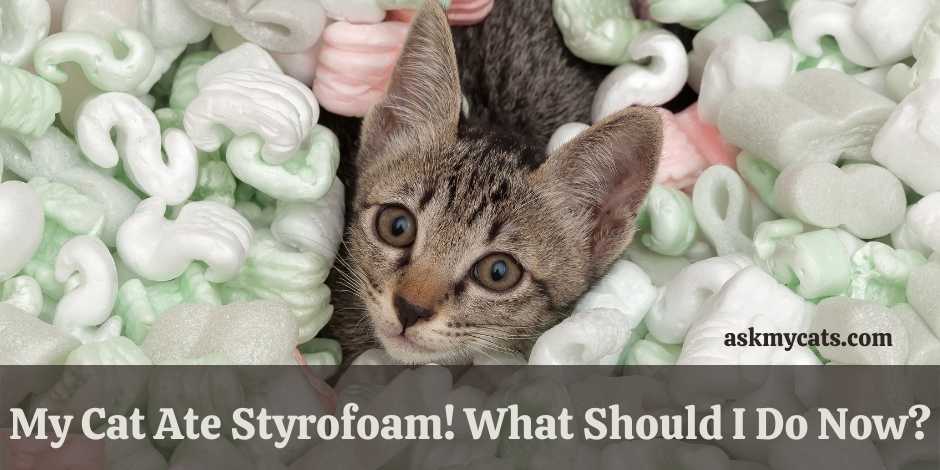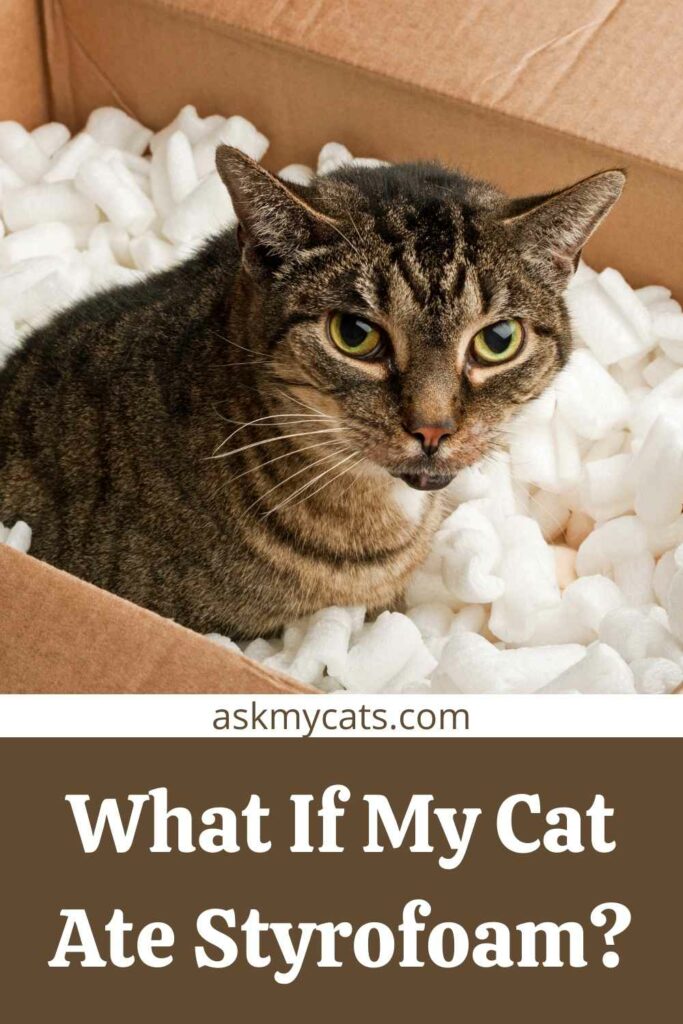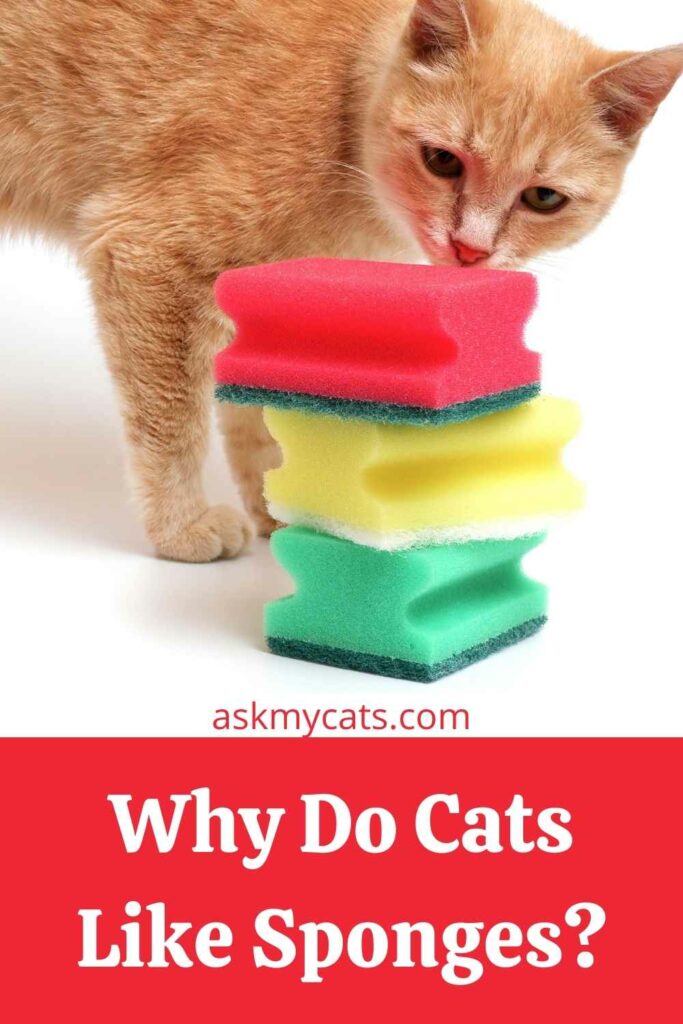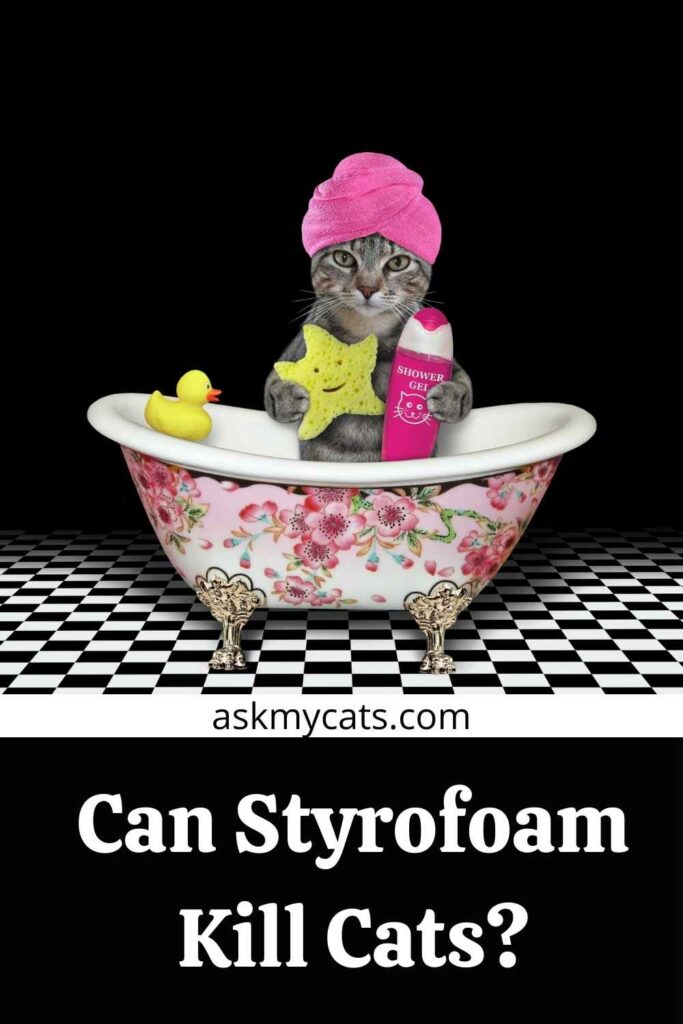Styrofoam is a polystyrene or plastic foam substance that has a wide range of applications. It is most often used in packaging and comes in a variety of forms such as packing peanuts, blocks, and beans.
When a cat eats Styrofoam, the first possible danger is choking.
Styrofoam beans are frequently seen in soft toys and other home goods like bean bags.
Styrofoam is also utilised in the manufacture of food containers such as burger boxes and coffee mugs. These may be more appealing to your cat since they frequently include leftover food flavours that may entice your cat to try them.


Give Your Cat the Perfect Day
Get the Free Ebook!
What If My Cat Ate Styrofoam?
If your cat ate Styrofoam, you should monitor them and contact your veterinarian. Depending on the amount consumed, Styrofoam can cause serious illnesses and can be fatal to cats.

Small particles of this substance have a tendency to adhere to the insides of the mouth and throat, and if consumed in large quantities, can restrict the route of air.
So, if you discover your cat chewing Styrofoam, remove it from her mouth as soon as possible. If you were too late and she had already eaten some, the following step depends on how much you believe she ate.
If these are minor issues, you may take a wait-and-see approach as long as you are constantly there to monitor your cat and inspect her litterbox every time she uses it. Do not attempt to induce vomiting at home without your veterinarian’s permission and guidance.
Foreign body blockage in the gastrointestinal tract (GIT), or the gut, is another big worry if a cat ate Styrofoam. This might happen if your cat ate a big amount of Styrofoam. If you witnessed your cat consume a lot of Styrofoam or believe she did, don’t put it off.
Take her to the vet as soon as possible! Diarrhoea (partial obstruction) or constipation is symptoms of intestinal blockage (full blockage). There will also be vomiting, a decrease of interest in food, water, and play, and her stomach will be uncomfortable to touch.
The hazard of GIT blockage is that food rots inside the gut when it is unable to travel down the intestines due to a mass of polystyrene blocking its passage.
There will also be vomiting, a decrease of interest in food, water, and play, and her stomach will be uncomfortable to touch. The hazard of GIT blockage is that food rots inside the gut when it is unable to travel down the intestines due to a mass of polystyrene blocking its passage.
This promotes the growth of dangerous bacteria in the gut, eventually leading to the death of portions of the stomach or intestines. As a result, harmful germs enter the bloodstream or these organs explode. In either case, these are both potentially fatal disorders. Following a physical examination of your cat and the necessary treatments like as x-rays and blood testing, your veterinarian may need to undertake a surgical surgery to remove the Styrofoam from inside the stomach.
Can Styrofoam Hurt Cats?
Styrofoam is not instantly harmful or poisonous to cats, which means that if your cat ingests it, they will not be impacted right away unless the amount consumed is large enough to induce asphyxia.
Having said that styrofoam is not safe for cats either.
This substance is composed of a form of plastic that does not degrade quickly in the environment, so you can imagine how dangerous it would be to have it lodged within your cat’s body.
Even while a single ingestion may not be harmful, repeated ingestions may be toxic, so be sure your cat does not have frequent access to styrofoam.
The third issue with a cat eating styrofoam is that it has the potential to be a toxin (poison) and a carcinogen (a substance capable of causing cancer in living tissue). While styrofoam is not considered acutely hazardous when consumed, it is still a good idea to get your cat’s liver and kidney functions checked by a veterinarian to rule out any damage to these organs caused by your cat’s styrofoam-eating escapade. Long-term cumulative exposure may cause cancer, so be sure your cat isn’t regularly ingesting styrofoam, even if she passes it out without mishap.
Is Foam Bad For Cats?
Foam is toxic to them because cats are unable to digest plastics and can cause stomach upset.
To cats, large bits of foam might be a choking hazard. If your cat ate a little piece of foam, the plastic ingestion should not have left any lasting effects.
The sponge might get stuck in the intestines and produce an obstruction, which could be very dangerous. An intestinal obstruction can soon become life-threatening, necessitating surgical intervention. You won’t be able to tell which cat ate the sponge if you try to figure it out at home.
To promote milk supply, kittens will knead their moms’ warm, fluffy underbellies. This kneading activity, which is similar to sucking one’s thumb, continues throughout adulthood as an instinctive “tick” that happens when a cat is relaxed and content.
Why Do Cats Like Sponges?
Cats like sponges because they are fascinated by fluffy things.

It’s possible that your cat has pica, which causes him to be fascinated with them. Simply defined, this is a condition in which the cat licks, chews, and eats things that aren’t food.
Cats, in theory, like to play with things rather than eat them. Pica sufferers, on the other hand, take things to a whole new level. Before consuming the non-food object, they will grasp it and crush it repeatedly with their back molar teeth.
Not every cat that enjoys a sponge is afflicted with pica. Some people are drawn to the material’s texture. They like how it feels in their mouths, how it bounces about, how easily it breaks apart, and so on. If the kitten plays with the sponge instead of eating it, the substance may be attractive to him.
For any of the three reasons stated above, some cats love playing with and chewing on sponges. Sponge, on the other hand, is disliked by the majority of them. If yours fits into the first group, attempt to figure out what motivates his conduct so you can determine whether or not he requires assistance.
A cat that enjoys all types of sponges has a good reason for doing so. Maybe he has pica, maybe he just likes the stuff, or he’s attempting to show off his hunting skills. You shouldn’t be concerned about his condition until he develops pica.
If you’ve had a cat for a long, you’re aware that when it comes to searching for prey, felines follow a set of rules. When the kitten captures anything, he tosses the dead animal about before carrying it and dropping it near you.
He’ll then meow a bit to draw your attention to it, or just to ‘present’ you with the prey. It’s a unique ritual that cats like. If your cat performs the same thing with the sponge, it’s likely that he’s trying to recreate what happens in nature.
Can Styrofoam Kill Cats?
Yes, styrofoam can kill cats as it may be fatal and cause blockage in windpipe.

The styrofoam does not instantly pose a concern to your cat until it becomes a choking hazard, as previously stated.
This might happen if your cat takes a huge amount of food at once or a portion that is too large for their throat.
Styrofoam has a hidden danger that is frequently overlooked: it sticks to whatever it comes into touch with, including your cat’s mouth and throat (digestive tube).
This implies that even if your cat ingests a tiny amount of the substance, asphyxia is still a possibility.
The easiest method to avoid this is to intervene as soon as possible and remove the styrofoam bits from your cat’s mouth.
The toxicity of Styrofoam is evident when the substance is consumed on a regular basis. It’s the same as giving your cat poison if you eat styrofoam more than once.
It will mostly damage the liver and kidneys, which will be unable to handle the plastic and may finally fail.
Your veterinarian will be able to determine whether styrofoam consumption is harming the organs through certain medical exams.
Cancer is another side effect of ingesting the toxic compounds in this plastic substance. If consumed on a regular basis, styrofoam can cause cancer.
Are Styrofoam Peanuts Toxic To Cats?
Yes, styrofoam peanuts are harmful to cats.
The starch in peanuts is non-toxic and originates from crop-based sources rather than petroleum-based plastics. Another advantage of biodegradable foam peanuts over polystyrene is that they have no electrostatic charge. They are also safe for people and pets if consumed unintentionally because they are biodegradable and harmless.
Because this is a quiet condition that may not exhibit signs until it’s too late, it’s critical that you don’t allow your cat get away with eating styrofoam on a regular basis, even if they don’t show any symptoms thereafter.
Cancer is difficult to cure in cats, and the prognosis is nearly invariably poor, with death occurring only a few months after diagnosis.
How Do I Stop My Cat From Eating Foam?
- Remove targeted items
- Simply hide the styrofoam items your cat loves to chew on
- Give your cat something else to chew
- Play with your cat
- Make appealing items unappealing
- Get rid of dangerous plants
- Talk to an animal behaviourist
What Should You Do If Your Cat Ate Styrofoam?
If your cat ate styrofoam by mistake, the first thing you should do is calculate how much styrofoam they ate.
Cats “attack” styrofoam with their claws or fangs, biting or shredding it into tiny, snowflake-like fragments.
Ingesting one of these small pieces shouldn’t be too harmful because your cat should be able to pass it without difficulty.
However, if a cat ate a lot of packing peanuts or swallowed a lot of them, it might be deadly.
If you’re not sure, one safe precaution is to give your cat spongy food like tuna with oil or cottage cheese after they’ve eaten styrofoam.
This sort of food will assist the styrofoam travel through your cat’s digestive system by wrapping around it.
In the hours following the intake, keep a watch on your cat for any odd behaviour or discomfort.
Your cat should be alright if it consumes the food, doesn’t throw up, and passes faeces properly in the next 48 hours.
It’s best to contact your veterinarian as soon as you see any signs of pain.
Frequently Asked Questions
Does styrofoam dissolve in stomach?
When eaten, Styrofoam is a foam material that does not break down or enter into the body. The majority of styrofoam fragments ingested by mistake are tiny enough to travel through the GI system without creating issues. Styrofoam degrades when exposed to heat or acids, producing hazardous compounds.
Is it OK for cats to eat styrofoam?
While styrofoam is not considered acutely hazardous when eaten, it is nevertheless a good idea to have your cat’s liver and kidney functions checked by a veterinarian to rule out any damage to these organs as a result of your cat’s styrofoam-eating escapade.
Can Cats Eat Styrofoam?
Cats cannot eat styrofoam, and as a pet parent, you should be particularly cautious about keeping it away from them because cats are drawn to it and may accidentally ingest a big amount.
Final Words
Ingesting styrofoam on a regular basis can lead to serious illnesses including gastrointestinal obstruction, partial necrosis, and even cancer. Cats have a proclivity for biting odd objects and may inadvertently consume stuff they aren’t supposed to.
It is your obligation to ensure that your home is cat-proof by removing or storing anything that might harm the cat’s health.
Please leave your questions about your pet friend’s feeding habits in the comments section below. We’ll get back to you as soon as possible.
